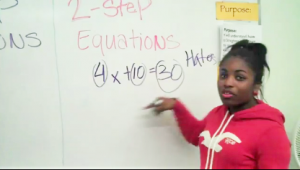
Upside Down Academy
By Chris Thompson
It’s a typical school day in Oakland, Calif., and Aaliyah is about to show how to solve two-step equations. Circling the three numbers in the equation 4x + 10 = 30, she says, “So one, two, three? Is a hater. They’re like haters... We trying to get rid of those numbers, ‘cause they hate on x. And we trying to have x protected.”
If that's an unusual way to characterize isolating the variable, that's because Aaliyah is an unusual teacher. In fact, she’s not a teacher at all -- she’s a student at the Envision Academy of Arts and Technology. Her algebra lesson is being filmed and posted on the Web.
Videos like Aaliyah’s are the brainchild of Jared Cosulich, a San Francisco-based tech entrepreneur who specializes in cooking up ideas for Web-based businesses (a Yelp-like site for weddings! A way to donate your birthday to charity!), and seeing if they work. He's deeply interested in education, and he’s creating a nonprofit known as the Upside Down Academy, hoping it'll catch on.
Cosulich took Salman Khan’s now-famous approach to creating short, easily made education videos and turned it on its head. Under Cosulich’s approach, teachers or mentors don’t make these videos. Students do -- as soon as they've mastered the material themselves.
“Learning is a lot more effective when you’re not just trying to consume information, but turning around and producing it as well,” Cosulich says. “A lot of this is about motivation, what motivates us to learn. At the end of the day, a lot of education gets divorced from purpose. This kind of gives people a purpose, to help someone else out.”

